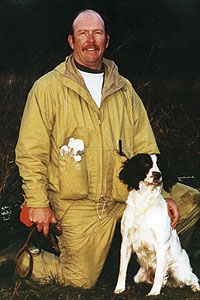By James B. Spencer
 This tip is from Mark Tholen of Ashcroft Kennels, 5020 South County Road 3, Fort Collins, CO 80528; (970) 493-7485; website www.ashcrofkennels,com; e-mail mltholen@jymis.com. Mark has been training professionally for 24 years. He trains all sporting breeds for hunting, but specializes in training spaniels for hunting, hunting tests, and field trials. He participates in field trials and hunting tests for spaniels as judge, handler, gunner and gun captain. He breeds field-bred English springer spaniels. |
"Gunshyness," Mark said, "is a common problem that sometimes masquerades as something else, like refusing to retrieve or bird-shyness."
Mark told of a client who brought his one-year-old pooch in to be cured of refusing to retrieve, but only when hunting. Mark accepted the dog and started testing him by tossing dummies and dead birds for him to retrieve. No problem. The dog bounced out, picked up the dummy or bird and bounced happily back to Mark.
He even retrieved just fine when a distant thrower threw marks and fired a cap pistol. However, when Mark tossed a dummy and fired a .22 blank pistol with the lightest load, the dog refused to leave his side. So Mark took the dog through the gun-proofing process (see below), after which the youngster retrieved beautifully, even with a 12-gauge booming right beside him.
Mark told of another client who brought in a young springer to be cured of bird-shyness. As soon as a bird flushed, this dog would run back to the truck. Mark asked the owner if the dog had been gun-proofed.
"Very thoroughly," the owner said. "I gun-proofed him while shooting coyotes from my car. I left the dog in the back seat while I got out, and used the hood of the car as a rest while I shot. Didn't bother him at all."
"What did he do?" Mark asked.
"He just curled up back there and laid very still."
Yeah, sure, Mark thought, the dog was probably terrified by those sharp rifle cracks and later transferred that fear to upland bird hunting situations in which the owner fired a shotgun at each flushed bird.
Here again, Mark cured the gunshyness and the bird-shyness disappeared.
| Don't Miss More Tips | 

Find tips for your pointer here, and your retriever here.
|
|
"Some few gunshy dogs," Mark said, "can never be cured. The problem has been too deeply ingrained for too long. But in most cases, I can cure it in two or three months."
The process for curing this problem is quite similar to the process for preventing it, so let's take prevention first. Mark starts a puppy retrieving in a hallway at about eight weeks of age. He starts by teasing the puppy with a rolled-up sock and then tossing it.
When the puppy runs out and picks it up, Mark claps his hands to encourage the puppy to return to him with the sock. Marks gradually introduces various dummies and eventually dead birds.
When the puppy is reliable in the hallway, Mark moves outdoors and lengthens the marks by having a distant assistant toss the dummy or bird. When the youngster is comfortable with this situation, Mark has his assistant fire a .22 blank as he throws, first at maximum distance (say 80 yards), then closer and closer, as long as the dog reacts positively.
When the youngster is comfortable with a .22 blank being fired beside him, Mark again lengthens the retrieves out to maximum distance, and has him fire a 20 gauge shotgun. And so on until the dog is comfortable with a 12 gauge being fired beside him.
Through this process, the dog comes to associate the sound of the gun with an opportunity to retrieve, and spaniels love to retrieve.
To cure a gunshy dog, Mark starts at the point in the above process that is most appropriate for the individual dog. If the dog retrieves dummies and bird at the maximum distance without gunfire, Mark starts him there, and then adds a cap pistol or .22 blank, and finally moving to smaller, then larger, gauge shotguns.
As an afterthought, Mark emphasized that you should never take a puppy to a shooting range of any kind to introduce him to gunfire. Instead of gun-proofing the puppy that will almost certainly make him gunshy. Then he had this advice for beginners:
"If your dog shows signs of sensitivity to gunfire, and you don't have any experience in curing this problem, you should seek professional assistance. A pro has all the equipment needed to cure this problem: dummies, birds, guns of various sizes, and so forth. Then, too, he can guide you in how to prevent a recurrence."






